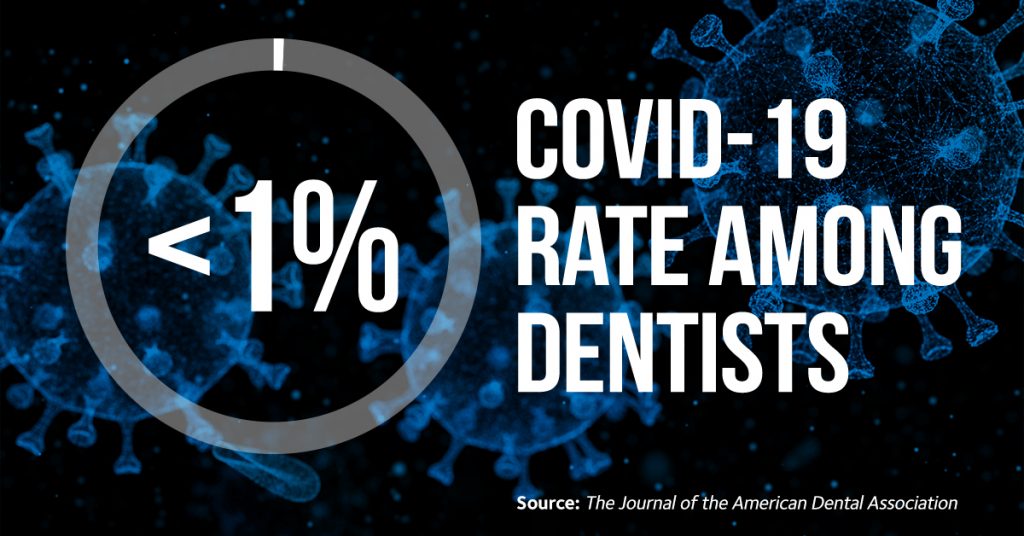Fewer than 1% of dentists nationwide were estimated to be COVID-19 positive as of June, according to an American Dental Association Science & Research Institute and Health Policy Institute study.
“Estimating COVID-19 Prevalence and Infection Control Practices Among US Dentists” (PDF), published online ahead of print by The Journal of the American Dental Association, is the first large-scale collection and publication of U.S. dentists’ infection rates and infection control practices related to COVID-19, according to the ADA.
In June, ADASRI and HPI researchers invited U.S. dentists practicing primarily in public health and private practice to participate in a web survey covering questions related to COVID-19-associated symptoms, COVID-19 infection, infection control procedures used in their primary dental practice, and mental and physical health conditions.
Of the 2,195 dentists who responded to the survey, 20 had a confirmed or probable COVID-19 infection. Respondents included dentists from every state and Puerto Rico. When the results were weighted according to age and location to approximate all U.S. dentists, 0.9% were estimated to have a confirmed or probable COVID-19 infection, with a margin of error of 0.5%.
“This is very good news for dentists and patients,” said Dr. Marcelo Araujo, Ph.D., CEO of the ADASRI, chief science officer of the ADA and senior author of the report. “This means that what dentists are doing — heightened infection control and increased attention to patient and dental team safety — is working.”
The results of the study will be shared during the ADA FDC Virtual Connect Conference’s opening session, COVID-19 and Beyond: Leading a Profession Through Uncharted Territory, scheduled for 5:30-6:15 p.m. CDT Oct. 15. ADA FDC 2020 registration will remain open at ADA.org/meeting throughout the conference, which ends Oct. 17.
The study found that 82.2% of the responding dentists were asymptomatic for one month before the survey, 16.6% had been tested for COVID-19, and 3.7% and 2.7% had tested positive via respiratory and blood samples, respectively, while none had tested positive with a salivary sample. Among those not tested, 0.3% had received a probable COVID-19 diagnosis from a physician.
“Understanding the risks associated with COVID-19 transmission in the dental setting is critical to improving patient and dental team safety,” Dr. Araujo said. “This study brings us another step forward in understanding what works. Dentists are following ADA and U.S. Centers for Disease Control and Prevention guidance, and it’s helping to keep the dental team and their patients as safe as possible.”
Interim guidance from both the ADA and CDC calls for dental professionals to use the highest level of personal protective equipment available, including masks, goggles and face shields. To minimize aerosols, the ADA guidance also recommends dental professionals use rubber dams and high-velocity suction whenever possible and hand scaling instead of ultrasonic scaling when cleaning teeth.
The researchers found that 99.7% of the dentists surveyed said they had implemented enhanced infection prevention and control procedures, including disinfecting all equipment and surfaces that are commonly touched, checking staff and patient temperatures, screening patients for COVID-19, encouraging distance between patients while waiting, and providing face masks to staff. While 99.6% of dentists reported using PPE when treating patients, 72.8% used PPE as recommended by interim guidance from the CDC. During the time evaluated by the survey, there were limited supplies of PPE, particularly N95 or equivalent masks.
In the two weeks before the survey, 33.9% of the responding dentists reported experiencing at least mild psychological distress, with 8.6% reporting symptoms of depression and 19.5% reporting symptoms of anxiety. About one-fourth of the respondents had at least one medical condition associated with a higher risk of developing severe illness from COVID-19.
The authors of the study are continuing to collect infection rate data, and they have added dental hygienists to their ongoing survey, in collaboration with the American Dental Hygienists Association.
In March, The New York Times listed dentistry as one of the professions at highest risk of COVID-19 infection based on data from O*NET, a database maintained by the U.S. Department of Labor. It was presumed that virus transmission could occur because of the close proximity between dental professionals and patients and because many dental procedures generate aerosols that may contain viral particles from infected individuals.
“The fact that dentistry was named one of the most at-risk professions for infection, but has a far lower prevalence of infection compared to other health professions, is not a coincidence,” said Marko Vujicic, Ph.D., chief economist and vice president of the ADA Health Policy Institute. “The profession has taken this issue extremely seriously, and it shows. We will continue to track the rate of COVID-19 among dentists and other facets of the pandemic affecting dentistry so it can help inform the dental profession and other industries as well.“




0 comments on “ADA study finds COVID-19 rate among dentists less than 1%”